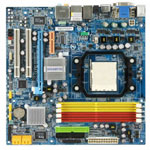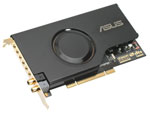AMD Midrange HTPC
To be honest, if there's one system in this roundup that is likely to get a lot of comments and criticisms, it's going to be the HTPC configuration. That's not to say that our particular configuration is unreasonable, but getting into the HTPC market we will invariably encounter a lot of differing opinions about what is necessary and what is not. We'll start with the assertion that anyone looking to build an HTPC already has a decent HDTV and sound system, so we get to bypass those expenses and focus on the rest of the components.
| AMD Midrange HTPC System |
| Hardware |
Component |
Price |
No Extras |
| Processor |
Athlon 64 X2 BE-2350 AM2 (2.1GHz 2x512K) - Retail |
$99 |
|
| Motherboard |
GIGABYTE GA-MA69GM-S2H (690G) |
$85 |
|
| Memory |
Transcend AxeRAM 2x1GB PC2-6400 (TX800QLJ-2GK) |
$75 |
|
| Video Card |
Integrated X1250 with HDMI |
$0 |
|
| Hard Drive |
HITACHI Deskstar 7K1000 750GB 7200RPM 32MB (HDS721075KLA330) |
$200 |
|
| Optical Drive |
Pioneer BDC-202BK Blu-ray/DVD+R Combo (SATA) - Optional |
$290 |
-$254 |
| Case and PSU |
Antec Veris Fusion (430W PSU) |
$175 |
|
| TV Tuner |
AVerMedia AVerTV Combo PCIe MCE (Retail) |
$115 |
|
| TV Tuner |
KWORLD ATSC 115 PlusTV HD (PCI) - Optional |
$76 |
-$76 |
| Sound Card |
ASUS Xonar D2 7.1 - Optional |
$181 |
-$181 |
| Display |
Pre-existing HDTV |
$0 |
|
| Speakers |
Pre-existing Home Theater Stereo |
$0 |
|
| Keyboard and Mouse |
Logitech 920-000526 Keyboard with 1500 Rechargeable Mouse |
$61 |
|
| Operating System |
Windows Vista Home Premium 32-bit (OEM) |
$105 |
|
| Bottom Line |
$1462 |
$951 |
 |
Our personal opinion is that an HTPC needs to be quiet above all else, and one of the best ways to achieve that result is to make sure you get a low-power processor. AMD's Athlon X2 BE-2350 meets that requirement, though obviously at a price premium. We're giving up 400 MHz compared to a stock 4800+ but spending the same amount of money. (You can also upgrade to the BE-2400 and give up 300 MHz compared to the 5000+ at the same price.) Our personal take on HTPC's is that raw CPU performance isn't a critical factor, but if you intend to do a lot of video transcoding you might need to upgrade the CPU to something faster. Unfortunately, a faster CPU will very likely mean something that generates more heat and thus requires better cooling. Most people looking at building an HTPC usually already have at least one other computer in the house, however, so having that system do transcoding over the network might help to keep noise levels in the living room down to an absolute minimum.
 |
Also worth mentioning is that we didn't bother with any super expensive memory, instead choosing some decent DDR2-800 memory that can provide 4-4-4 timings. We aren't interested in overclocking this HTPC (though it's technically still possible), and spending additional money on higher performance RAM just doesn't make sense. In fact, as we alluded to earlier, many people might simply want to purchase this cheaper memory on the gaming configurations as well.
 |
Moving on to the motherboard, we come to the primary reason for selecting an AMD platform for our HTPC. While it's possible to find Intel platform motherboards with an HDMI port, you're really talking about some slim pickings right now. As a whole, we simply feel AMD's Radeon X1250 (690G) is a better IGP, especially when looking at the HTPC market. If you're looking for a close second to the Gigabyte board (which is currently our favorite HTPC motherboard after testing), the abit AN-M2HD (which uses an NVIDIA GeForce 7050 chipset) offers similar features and performance at a slightly higher price. It also includes Shader Model 3.0 support for your gaming pleasure, for those who enjoy SM3.0 gaming slideshows.
(Ooooooh! Aaaaaaah!)
Because we used an integrated graphics solution, obviously there's no need for a discrete graphics card. Of course, some people might prefer a discrete graphics solution that includes hardware accelerated H.264 decoding, in which case you could skip out on the IGP motherboards and pick up pretty much any other reasonable motherboard. If you're looking to build an HTPC based on an Intel platform, this is definitely the route we would take. GeForce 8600 and Radeon HD 2600 cards should all do a reasonable job at handling any H.264 content, although we were able to decode everything up through 1080i H.264 videos fine using just the CPU. 1080p on the other hand needs a bit more help. If you want to install an HD-DVD and/or Blu-ray drive, we would definitely put more thought into spending an extra hundred dollars or so on a discrete (fanless) GPU.
Any HTPC worth its salt needs to be able to record videos, so we added a TV tuner card. The AVerMedia AVerTV Combo is a dual TV tuner that supports Over-the-Air HDTV signals (ATSC), Clear QAM, as well as analog channels. It integrates with Windows MCE 2005 and Windows Vista, but you'll need to use the separate AVer MediaCenter application (currently a free trial that doesn't expire) in order to view QAM digital channels. Scanning through all the QAM channels to get things configured can be a tedious process, but for QAM support it's pretty much a necessary evil. Heat is also a concern at times, according to online comments.
If you want to be able to record/view additional channels, you can install a second card as well. The retail box includes a Media Center remote and IR blaster, but you only need one of those so if you pick up a second card you can save a bit of money and get the white box version. However, you need a motherboard with two PCIe x1 slots if you want to use two of these cards, so either you'll need to get a different motherboard or you'll need to pick up a PCI card for your second tuner. The "best" current option (and we use that term loosely) seems to be the KWORLD ATSC 115, which has similar features to the AVerMedia card and includes a second remote. Some users have had serious issues while others don't report any problems, but we generally consider this to be an optional extra. AMD also
just announced their new TV Wonder lineup with Clear QAM support which should become available shortly. We're certainly interested in seeing how the actual hardware and software turns out, but until the products actually become available we'll have to stick with other alternatives.
Now, there's something else to consider in all of this, and that's the US government mandated February 19, 2009 deadline to end analog broadcasts. Both of the TV tuners that we've listed include analog support, which we still find to be necessary in order to view the largest number of channels. However, some people might prefer to just forget about analog altogether - especially those that live in larger metropolitan areas where the switch to digital TV is already well underway. One final option on the TV tuner side that is pretty unique is the HD Homerun from Silicondust USA. This is a Dual HDTV tuner/recorder that functions over a network and provides ATSC/QAM support. The price of $169 is more than many other options, but this is arguably a more flexible overall solution.
What's the point of having an HTPC if you don't have a lot of storage space? To that end, we selected a Hitachi 750GB hard drive - if you're recording HDTV signals, you will chew through space at a rate of around 8GB per hour, which still gives enough storage for over 90 hours of video. We also have what we can only consider an optional Blu-ray/DVDR combo drive - optional because at $290, most people might be inclined to wait a bit longer. If you don't want to spend that much (or simply feel Blu-ray and HD-DVD are overrated), feel free to stick with our standard SATA DVDR recommendation from the other configurations.
 |
Another optional component is the sound card. Windows Vista has done a lot to level the audio playing field, and honestly most of us are perfectly happy using integrated audio. Still, for audiophiles, the ASUS Xonar D2 provides a noticeably better experience. The integrated HDMI port only provides stereo audio pass-through, so if you're hooking up to a good home theater system, you will almost certainly want to use a separate S/PDIF output. The motherboard we selected does include that feature, but the Xonar adds DTS support. At almost $200, however, this may be a luxury that most users are willing to forgo.
 |
Finally, while it is certainly possible to stuff all of these components into pretty much any ATX/uATX case, a real HTPC needs to blend in with its environment a bit better. The Antec Veris Fusion is a decent looking uATX HTPC case that includes a 430W power supply and a VFD panel. Getting everything installed and wired correctly can take some effort compared to your typical PC chassis, but the end result is a lot more visually appealing. Unfortunately, the case doesn't include any sort of remote control, so you will need to purchase one separately. We wouldn't call this a perfect case by any means, but it still offers a good value and looks attractive, making it a good choice for a midrange HTPC. We also included a wireless keyboard/mouse from Logitech, for those times when the remote control just doesn't cut it.
While we prefer the ease of installation that comes with Windows Vista, all of the TV tuners mentioned above should also work with MythTV. That will almost certainly require a lot more effort, and as with most things Linux you may have better results by using an NVIDIA graphics chip. If you've got more time than money, though, MythTV can be a very powerful alternative that still provides good quality. On the other hand, if digging through forums and recompiling kernels and drivers doesn't sound like your cup of tea, Vista remains the far easier solution.
The final price comes to just under $1500, but as we've already mentioned there are several optional features that many people might choose to bypass. If you cut out the Blu-ray drive (and substitute in a standard DVDR), the extra PCI tuner, and the ASUS soundcard you can get the price to $950. Go with MythTV and you can cut out another $105. Clearly, there's a lot of room for tweaking this particular configuration to fit your own needs.















41 Comments
View All Comments
cosmotic - Monday, October 15, 2007 - link
It would be really cool if you guys built the Intel and AMD system's and put them head to head in benchmarks.